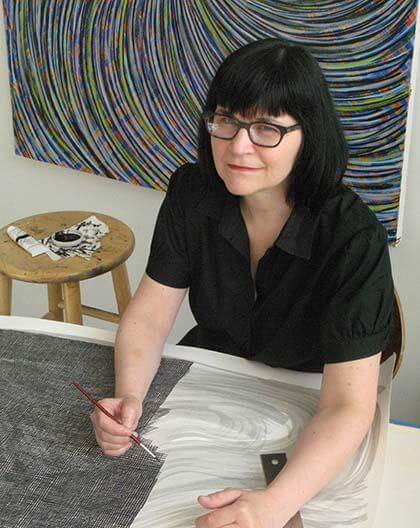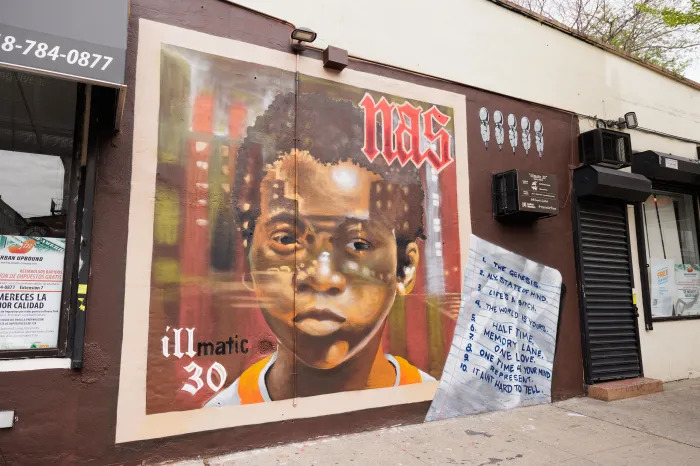By Allison Plitt
Jackson Heights artist Jean Foos has developed an artistic process that could fool the eye of any viewer.
Her paintings and drawings appear to be spirals, webs and waves of vibrant colors. Beneath the surface of her pictures, however, are layers upon layers of varying lines and hues that create the illusion of simple geometric patterns.
Foos’ artwork is anything but simple. Some of her paintings have 25 layers of oil and acrylic paint.
“My painting is totally intuitive. I keep piling on until it’s done. I don’t always know when it’s done,” she explained. “It takes a long time. Sometimes I put on a layer and I don’t touch it for months and months.”
For example, in her piece “Hanabi,” Foos had originally painted a canvas of interweaving lines. When the colors of the lines didn’t appeal to her, she would paint over them to blend the hues together. As soon as she felt satisfied with the shades, she found the colors to be “vibrant but flat.” To add another dimension to her work, she painted a spinning vortex on top of the lines.
Foos’ drawings are more meticulously arranged than her paintings. For all of her drawings, she creates a bottom layer of undulating lines followed by a second layer of tiny measure grids. The combination of the waves and the grids produces a mesh-like appearance.
“There’s some kind of precision,” she observed. “I don’t like it to look particularly labored, but it looks like it’s all come together. It’s very much a thinking, doing and thinking-some-more process. It’s like a puzzle – trying to find out what to do next.”
Although Foos admits her art is highly influenced by the minimalist tendency to reduce a subject to its most basic elements, she identifies more with abstract expressionists such as Willem De Kooning and Robert Motherwell, who broke away from representational painting by creating abstract images.
Like Foos, these artists painted with a spontaneity that allowed them to express their creativity and subconsciousness yet many of their works were highly planned.
“In terms of abstract expressionism, there’s a kind of freedom and power to it for me,” she said. “It’s more daring to not try to render an object or make it look like something everybody can see. It’s a little more experimental, seeing what happens.”
Foos’ career as an artist seems almost predestined. Growing up in suburban Greece, NY, she was surrounded by a family of artists. Her mother is a painter, her grandfather was a portrait photographer and her grandmother was a quilter.
Feeling confined in the suburban environment, Foos said she “escaped” to New York City where she enrolled at Cooper Union. Besides studying painting, she also took courses in photography, art history, drawing and animation.
Since graduating from Cooper, Foos has immersed herself in her artwork both academically and professionally. She received an MFA from the Tyler School of Art in Philadelphia, received a fellowship to study painting in Italy and was awarded a Visual Art Fellowship from the National Endowment for the Arts.
While exhibiting her work in galleries throughout the United States and Europe for the past 30 years, she has worked in graphic design and production at various magazines.
During the late 1970s and 1980s, she lived in Manhattan’s East Village during the rise and fall of its music and art scene. Foos said she also had many gay friends in this community and was involved “in the politics and pain of the AIDS epidemic.” She continues to work with an organization called Visual AIDS which is committed to fighting the AIDS disease and supporting HIV positive artists.
Despite living through an era of such upheaval, Foos quietly reflects back to her time at Cooper Union where her interest in art was instilled by teachers such as abstract painter Jack Whitten and art critic Dore Ashton.
“Dore Ashton really encouraged us to go to the museums and look at the art, not just the art from art magazines and art history books but to go to the museums and experience it,” Foos recounted. “I had some great teachers that would come with us to museums and tell their stories. That sort of early excitement has never left me — how dynamic and thrilling it is to be a painter.”
For more information about Foos’ artwork and upcoming exhibits, you can visit her website at https://jeanfoos.com/.






























